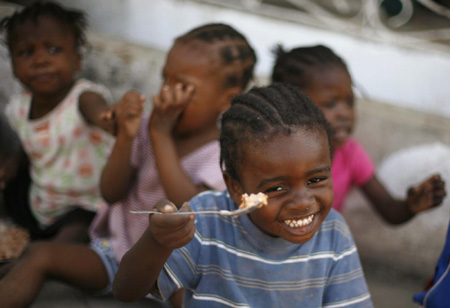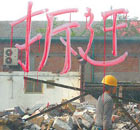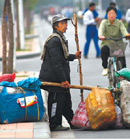Top News
Survivors flee Haiti capital; buried still saved
(Agencies)
Updated: 2010-01-23 13:52
 |
Large Medium Small |
PORT-AU-PRINCE, Haiti: By boat or by bus, by bicycle and on foot along clogged and broken roads, earthquake survivors streamed away from this city and its landscape of desolation Friday and into Haiti's hinterlands and the unknown.
|
 A child smiles at the Maison Des Affaires de Dieu orphanage in Port-au-Prince January 22, 2010. [Agencies] |
The government and international agencies urgently searched for sites to build tent cities on Port-au-Prince's outskirts to shelter hundreds of thousands of the homeless staying behind before springtime's onslaught of floods and hurricanes.
Into this bleak picture Friday came stunning word of rescues from beneath the ruins, 10 days after the killer quake.
An Israeli search team pulled a 21-year-old man from a crevasse in the rubble of what had been a two-story home.
Emmannuel Buso, a student and tailor, was so ghostly pale that rescuers said his mother thought he was a corpse. He said he survived the ordeal in part by drinking his own urine. Doctors said he is expected to make a full recovery.
"I am here today because God wants it," Buso said from his bed at an Israeli field hospital.
Earlier Friday, an 84-year-old woman was said by relatives to have been pulled from the wreckage of her home, according to doctors administering oxygen and intravenous fluids to her at the General Hospital. They said they had little hope the woman, in bad condition, would live.
The 7.0-magnitude quake struck Jan. 12 and killed an estimated 200,000 people, according to Haitian government figures cited by the European Commission. Countless dead remained buried in thousands of collapsed and toppled buildings in Port-au-Prince, a city of slums that drew migrants from an even more destitute countryside.
Now that movement has abruptly reversed, as quake victims, with meager belongings, jam small buses and battered automobiles, take to bicycles or just walk to outlying towns and rural areas, to relatives or whatever shelter they can find.
They jammed a simple Port-au-Prince wharf as well, in hopes of a spot aboard an outbound skiff sailing up the coast. "I'll wait till I find one," said Edson Roddy, 18.
"A lot of people are leaving. You can't imagine how many people are going back home," said Menoir Sadeius, 24, who works small school buses with passengers, earning $3 each time he crams 27 people on board.
As many as 200,000 have fled the city of 2 million, the US Agency for International Development reported, citing a Haitian survey of bus stations and of sources in destination towns. At St. Marc, 40 miles (70 kilometers) to the north, most arrived with injuries from the quake, the US agency said.
Now huddled with cousins in that dusty seaside town, Port-au-Prince refugee Daniel Dukenson said his nephew and sister, pulled from the family's fallen house after the quake, were recuperating.
"I'd like to go back," the 28-year-old computer teacher said. "But it's going to take a lot of time for Port-au-Prince to get back on its feet. Two years maybe."
The end of the road didn't always offer relief, however. At least 100,000 people may have fled farther north, to Gonaives, a city of 280,000 devastated by back-to-back hurricanes in 2008.
"We are working with authorities to discourage people from going to Gonaives," said Myrta Kaulard, country director of the UN World Food Program. "It is a very dangerous town and it is still partially destroyed from the hurricanes."
Brazilian UN peacekeepers and work crews have begun clearing a site at Croix-des-Bouquets, just northeast of Port-au-Prince, for what may become a tent city for 30,000 people, the International Organization for Migration said.
Six other sites have also been identified, but it will probably take weeks before the first camps accept Port-au-Prince's homeless, the group's spokesman Jean-Philippe Chauzy said in Geneva.
Such camps "cannot be built overnight," said the agency's Haiti mission chief, Vincent Houver. "There are standards that have to be designed by experts. There is the leveling of the land, procurement and delivery of tents, as well as water and sanitation."
Many quake victims may resist the voluntary resettlement, wary of moving farther from their wrecked homes and their possessions inside, or from relatives. But the need for shelter and security will likely prevail, Chauzy said, particularly as hurricane season approaches in June.
While plans were drafted for major relocations, scores of aid organizations, big and small, stepped up deliveries of food, water, medical supplies and other aid to the homeless and other needy of Port-au-Prince.
The WFP has distributed more than 1.4 million rations - each containing three meals - since the quake and is bringing in 16 million more. "We are planning to flood the country with food," Kaulard said.
The US military, whose more than 2,000 troops on the ground have helped speed aid deliveries, reported steady progress overcoming obstacles that have slowed relief efforts, including in the outlying quake zone.
"Each day we are getting better and better and extending our reach to more and more of Haiti," said Army Col. Bill Buckner.
The world's nations have pledged almost $1 billion in relief aid, and more was on the way: Top-name international celebrities from film, music, sports and politics, from Beyonce to Leonardo DiCaprio, headlined a two-hour telethon Friday night to raise funds for Haiti.













